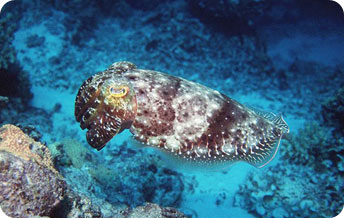Radio Program
Our regular Science and the SeaTM radio program presents marine science topics in an engaging two-minute story format. Our script writers gather ideas for the radio program from the University of Texas Marine Science Institute's researchers and from our very popular college class, Introduction to Oceanography, which we teach to hundreds of non-science majors at The University of Texas at Austin every year. Our radio programs are distributed at to commercial and public radio stations across the country.
In the movies, any big surge of water from the oceans -- the result of an underwater earthquake or a crashing asteroid -- is often called a tidal wave. But it’s another case of Hollywood not quite getting things right. A tidal wave is a predictable event. But a giant wave created in a violent event is known as a tsunami.
{mosimage}
The bottom of the Gulf of Mexico leaks like a roof after a hailstorm. Oil and natural gas ooze up through cracks in the seafloor. But these cracks aren’t zones of death, as you might expect. Instead, they’re home to thriving colonies of tube worms, crabs, and other animals -- including tiny creatures known as “ice worms.”
The bottom of the Gulf of Mexico leaks like a roof after a hailstorm. Oil and natural gas ooze up through cracks in the seafloor. But these cracks aren’t zones of death, as you might expect. Instead, they’re home to thriving colonies of tube worms, crabs, and other animals -- including tiny creatures known as “ice worms.”
{mosimage}
As supplies of oil and natural gas continue to shrink, scientists are looking for new sources of energy to replace them. One place they’re looking is the bottom of the oceans. Huge amounts of natural gas -- mostly methane -- are “frozen” in layers known as gas hydrates.
As supplies of oil and natural gas continue to shrink, scientists are looking for new sources of energy to replace them. One place they’re looking is the bottom of the oceans. Huge amounts of natural gas -- mostly methane -- are “frozen” in layers known as gas hydrates.
{mosimage}
The cuttlefish is the “stealth fighter” of the seas. It disguises itself by changing colors, scares off rivals with bold patterns, and eludes predators by dropping decoys. And if all else fails, it’s jet propelled.

The cuttlefish is the “stealth fighter” of the seas. It disguises itself by changing colors, scares off rivals with bold patterns, and eludes predators by dropping decoys. And if all else fails, it’s jet propelled.
{mosimage}
Hurricane experts are predicting a busy season this year. And that could mean bigger-than-usual “red tides” later on.
{mosimage}
A red tide is a “bloom” of algae in coastal waters. Some blooms are harmless. But some contain a species of algae that produces toxins that can kill fish and birds and harm people.
Hurricane experts are predicting a busy season this year. And that could mean bigger-than-usual “red tides” later on.
A red tide is a “bloom” of algae in coastal waters. Some blooms are harmless. But some contain a species of algae that produces toxins that can kill fish and birds and harm people.
Currents of warm, salty water flow from the Mediterranean Sea into the Atlantic Ocean. Their high salt content makes the currents denser, so when they enter the Atlantic, they sink and form big eddies that spin at depths of more than half a mile. Called “meddies,” they help drive ocean currents that help keep Europe relatively warm.
{mosimage}

